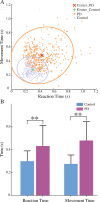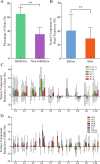Evaluation of tremor interference with control of voluntary reaching movements in patients with Parkinson's disease
- PMID: 30866977
- PMCID: PMC6417201
- DOI: 10.1186/s12984-019-0505-0
Evaluation of tremor interference with control of voluntary reaching movements in patients with Parkinson's disease
Abstract
Background: A large population of patients with Parkinson's disease (PD) displays the symptom of resting tremor. However, the extent that resting tremor may affect the performance of movement control has not been evaluated specifically. This study aims at establishing methods to quantitatively evaluate motor performance in PD patients with tremor, and at analyzing the interfering effects of tremor on control of reaching movements.
Methods: Ten PD patients with tremor and Ten healthy control subjects were recruited to participate in this study. All patients and healthy control subjects performed point-to-point reaching movements with their tremor affected arm or preferred arm. We verified that a smoothing model of minimum-jerk trajectory (MJT) can be used to extract voluntary movement trajectory from tremor-corrupted movement trajectory in the reaching tasks by the patients. Performance indices of reaction time (RT) and movement time (MT) of reaching movements by the PD subjects with tremor were evaluated using MJT trajectories. Differences of RT and MT between the recorded trajectories and MJT in PD and control subjects were calculated to investigate the extent that tremor may affect their motor performance. Linear mixed-effects model was used to identify the contributions of tremor, bradykinesia and rigidity to the performance indices of RT and MT based on UPDRS scores. The power spectrum densities (PSD) of tremor were also evaluated using hand velocities to represent tremor intensity and to analyze their correlations with RT and MT.
Results: The MJT model demonstrated good fit to recorded trajectory with a more consistent estimation of motor performance for both PD and control subjects. The RT and MT of patients were found to be 43.4 and 79.5% longer respectively than those of healthy control subjects. Analysis of the linear mixed-effects model was not able to reveal that tremor, bradykinesia and rigidity each had a significant contribution to RT or MT in PD patients with tremor. However, the PSD of tremor was found to correlate significantly to RT, but not to MT, in both linear regression and linear mixed-effects model.
Conclusions: The minimum-jerk trajectory and power spectrum densities are effective quantitative tools for evaluating motor performance for PD patients with tremor. Resting tremor is one of the factors prolonging the initiation of voluntary reaching movement in these patients.
Keywords: Movement time; Parkinson’s disease; Reaching movements; Reaction time; Tremor.
Conflict of interest statement
Ethics approval and consent to participate
This study was approved by the Ethics Committee of Animal and Human Subject Studies of Med-X Research Institute, Shanghai Jiao Tong University. The subjects were given the written informed consent form, and they signed the consent form before joining this study.
Consent for publication
The authors consent this article for the publication of Journal of NeuroEngineering and Rehabilitation.
Competing interests
The authors declare that they have no competing interests.
Publisher’s Note
Springer Nature remains neutral with regard to jurisdictional claims in published maps and institutional affiliations.
Figures






Similar articles
-
The impact of evoked cutaneous afferents on voluntary reaching movement in patients with Parkinson's disease.J Neural Eng. 2019 Jun;16(3):036029. doi: 10.1088/1741-2552/ab186f. Epub 2019 Apr 11. J Neural Eng. 2019. PMID: 30974418
-
The impact of ventrolateral thalamotomy on tremor and voluntary motor behavior in patients with Parkinson's disease.Exp Brain Res. 2006 Apr;170(2):160-71. doi: 10.1007/s00221-005-0198-4. Epub 2005 Nov 23. Exp Brain Res. 2006. PMID: 16328283 Clinical Trial.
-
[A rapid detection of motor block in patients with Parkinson disease during volitional movements of the hand].Srp Arh Celok Lek. 2002 Nov-Dec;130(11-12):376-81. doi: 10.2298/sarh0212376p. Srp Arh Celok Lek. 2002. PMID: 12751160 Serbian.
-
The Motor Syndrome of Parkinson's Disease.Int Rev Neurobiol. 2017;132:25-32. doi: 10.1016/bs.irn.2017.01.004. Epub 2017 Feb 24. Int Rev Neurobiol. 2017. PMID: 28554410 Review.
-
Tremor: how to determine if the patient has Parkinson's disease.Geriatrics. 1998 May;53(5):30-6. Geriatrics. 1998. PMID: 9597978 Review.
Cited by
-
Submovements in manual tracking: people with Parkinson's disease produce more submovements than age-matched controls.J Neuroeng Rehabil. 2025 Mar 6;22(1):51. doi: 10.1186/s12984-025-01592-1. J Neuroeng Rehabil. 2025. PMID: 40050876 Free PMC article.
-
Modeling of cerebellar transcranial electrical stimulation effects on hand tremor in Parkinson's disease.Front Aging Neurosci. 2023 Nov 13;15:1187157. doi: 10.3389/fnagi.2023.1187157. eCollection 2023. Front Aging Neurosci. 2023. PMID: 38020756 Free PMC article.
-
Statistical Analysis and Kinematic Assessment of Upper Limb Reaching Task in Parkinson's Disease.Sensors (Basel). 2022 Feb 22;22(5):1708. doi: 10.3390/s22051708. Sensors (Basel). 2022. PMID: 35270853 Free PMC article.
-
Adaptive auditory assistance for stride length cadence modification in older adults and people with Parkinson's.Front Physiol. 2024 Feb 7;15:1284236. doi: 10.3389/fphys.2024.1284236. eCollection 2024. Front Physiol. 2024. PMID: 38384796 Free PMC article.
References
-
- Jankovic J, McDermott M, Carter J, Gauthier S, Goetz C, Golbe L, et al. Variable expression of Parkinson’s disease: a base-line analysis of the DATATOP cohort. The Parkinson Study Group Neurology. 1990;40:1529–1534. - PubMed
Publication types
MeSH terms
LinkOut - more resources
Full Text Sources
Medical

